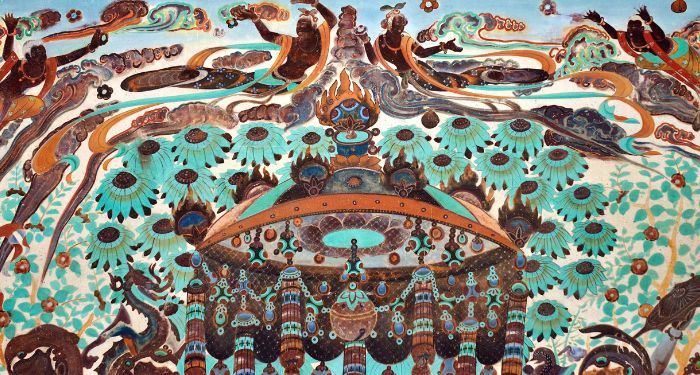
Give Us These Retellings, Stat!
We love retellings. Humanity has been rehashing the same stories like a multi millennia-long game of telephone. From myths and fables to fairy tales and urban legends, we love to share our favorite stories, adding details and cutting out the dull bits. In the last few years, there’s been a spike of interest in mythology retellings. Greek and Roman mythology has always been popular, but thanks to books like Madeline Miller’s The Song of Achilles, they’re the current unstoppable mythic pantheon. Petty arguments and messy breakups — gods they’re just like us!
Retellings can be new and exciting, allowing for creativity within a well-known story. There’s comfort in knowing what’s going to come next. The surprise in reading retellings comes in an author’s unique voice. Rather than scoffing at “another remake,” retellings should be embraced as part of our storytelling history.
The world is so packed with myths and fairy tales that we’ve only scratched the surface in terms of retellings and adaptions. I want to see family saga style novelizations of world mythologies. Give me more fairy tales from around the world, turned into romcoms and historical fiction. The stories that have been passed on through oral tradition and bedtime story books have become the source for so many of our favorite media pieces of today.
This list is just a few of the tales that I think should be retold in a literary format.
La Llorona (Mexican/Central American/Southwest USA Legend)
La Llorona, like many folk ghost tales, is that of a grieving mother. With roots in Precolonial Mexico, La Llorona is said to be a vengeful spirit who haunts dangerous bodies of water. La Llorona supposedly drowned her own children in a fit of rage, and she appears as a wailing woman in white. She is considered an omen, or warning, depending on how you receive her presence. One version of the story states that La Llorona is based on La Malinche, the Nahua woman who acted as Cortés’s interpreter during his conquest of Mexico and later became his mistress. According to this story, La Malinche murdered her child after Cortés returned to Spain. The first recorded story of La Llorona appeared in 1550 in Mexico City. The story of La Llorona continues to circulate as a folk legend and regularly inspires TV, film, and novelizations like The Haunting of Alejandra and Paola Santiago and the River of Tears. I’d love to see a historical fiction take on La Llorona or something that leans even more into the horror/ghost story.
Thor’s Fishing Trip (Norse Mythology)
According to Norse mythology, Thor, god of thunder, and Jörmungdr, the massive sea serpent, are sworn enemies whose final battle will culminate in the apocalypse, or Ragnarök. The fishing trip myth features Thor and Hymir, the giant, rowing out to sea. Thor takes hold of Jömungdr and attempts to pull the serpent to land, causing great waves and destruction. Jömungdr spews poison and Hymir cuts the fishing line. Thor throws his mighty hammer after the serpent, but it’s too late. In other versions, Thor kills Jömungdr with his hammer. This tale is a popular motif in Norse art, with some images dating back to the 8th century. Neil Gaiman covered this myth in Norse Mythology, but I’d love to see an expanded novelization of this story.
Three Sisters (North American Legend)
Different versions of this agricultural legend exist throughout the Americas, via Indigenous nations. The simplest version of the story is about three sisters who were very different from each other. One was tall and pale, one was fast and small, and one was short and plump. They learned to work together to shelter and take care of each other. Their harvest was bountiful and warm. The sisters, of course, are corns, beans, and squash. Some versions of the story feature a boy bringing the sisters to his home, to show the different times for harvest. This legend is well preserved as an oral tale, but hasn’t been fictionalized.
Tulisa, The Woodcutter’s Daughter (Indian Fairy Tale)
This beloved legend was first published in the 11th century in an annex to the Kathāsaritsāgara. Similar to other animal bride/bridegroom stories, this story follows Tulisa who hears a voice in a fountain. The voice belongs to the Prince of Snakes, asking for her hand in marriage. The Prince promises riches to Tulisa’s father. Tulisa weds the owner of the voice, sight unseen. Tulisa is forbidden from leaving the palace or receiving visitors. When an old woman comes to the door for help, Tulisa lets her in. The old woman advises Tulisa to ask for her husband’s real name. When his real name, Basnak Dau, is revealed, he turns into a snake and slithers away into the river. The palace disappears and Tulisa must return to her father’s home. To restore the Prince to his throne, Tulisa must accomplish three tasks. Filled with magic and clever animals, this is a Disney-esque tale ripe for retelling.
The Cowherd and Weaver Girl (Chinese Myth)
Variations of this celestial myth exist across Asia, and have been told at least since Han Dynasty. In the Chinese version, Zhinu, the weaver girl, is in love with cowherd, Niulang. They are represented by the stars Vega and Altair respectively. A simplified version of the story is that Zhinu, a goddess, fell in love with the mortal Niulang while visiting earth. Zhinu and Niulang had two children before Zhinu was called back to heaven to resume her weaving duties.
Desperate to get his love back, Niulang disguised himself in an ox pelt to travel to heaven. The goddesses banished Niulang to other side of the heavenly river. The lovers were granted a once-a-year reunion, on the seventh day of the seventh month when magpies form a bridge. The Cowherd and Weaver Girl story, and other folk tales work to explain celestial phenomena, but why is Barry Hughart’s 1984 novel the only novelization? Can we get a historical romance?
Starlight (French Fairy Tale)
We are up to our collective ears in Beauty and the Beast retellings, so there’s room for another French fairy tale. The original tale begins in a kingdom constantly at war, the prince having fallen in love with an enslaved girl, Starlight. The king and queen have the girl imprisoned, with only a talking white cat for company. Starlight confides in her cat, and the cat reveals herself as a fairy. The cat gives Starlight magical gifts and a warning before leaving.
Starlight sets out to find the prince, they are reunited and find refuge with centaurs. When they set sail for home, a deadly storm separates Starlight and the prince. The prince finally arrives home to find both his parents dead, and becomes king. Meanwhile, Starlight ends up in a faraway kingdom, only to be betrayed by her rescuers. Using the gift the fairy-cat had given her, Starlight is able to reunite with her first love and they marry. Starlight was first published in 1753 in a book of fairy tales, by Marie-Madeline de Lubert, with few adaptations since.
How the Stallos Were Tricked (Sámi Fairy Tale)
This particular story was published in the 19th century, but ancient buildings throughout modern-day Norway, Sweden, Finland, and Russia are attributed to the mythic giants. The Stallos are supposed large, humanish creatures with a hunger for human flesh. Their clumsy nature and low intelligence make gathering their preferred food difficult. In this story, a group of neighbors band together to trick the giant, avenging the death of their loved ones. As a horror novel or thriller, this dark tale of revenge would send shivers down your spine.
Dionysus (Greek Mythology)
If any Greek god is still missing a novelization, it’s the god of wine and theatre. Dionynus, son of Zeus, is regarded as one of the earlier members of the accepted Greek pantheon. The myths of Dionysus are full of death and rebirth, far-reaching travels, and discovery. With multiple origin myths and appearances in other popular myths, this party god is ready for his own time in the spotlight.
What myth or folk legend would you love to read a retelling of next? Visit our myth and folklore archives for books to read now, and check out retellings to add to your TBR for later.


